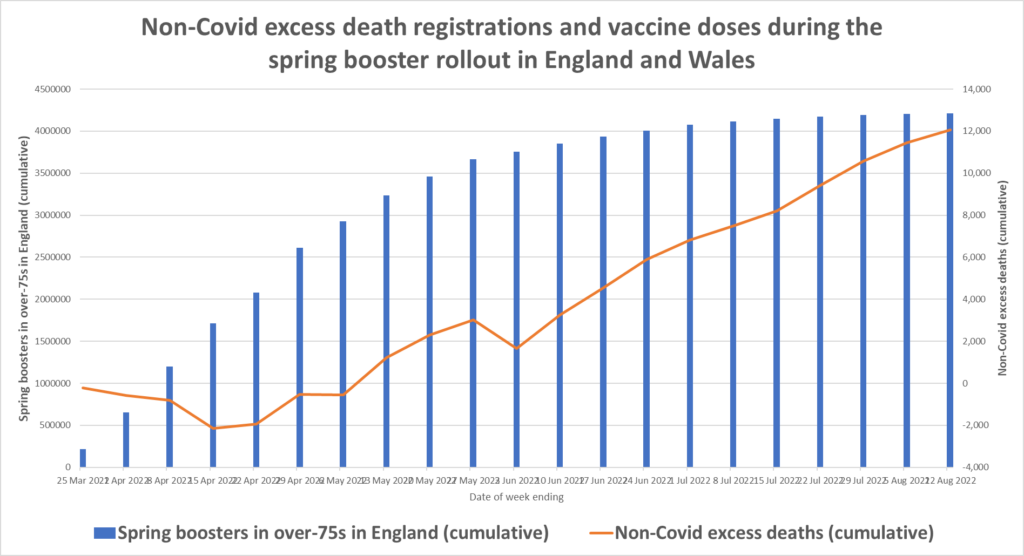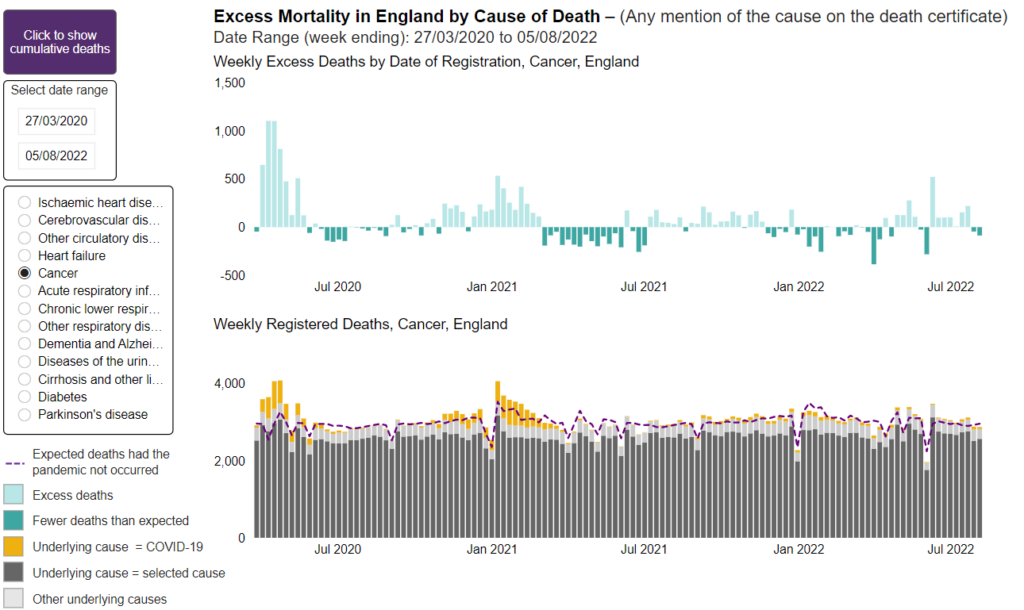The U.K. conducted a unique experiment beginning in late March and winding up in late August. All over-75s were offered a second ‘booster’ vaccination (fourth jab) and to date around 80% have taken up the offer.

In a previous article I highlighted the increased vulnerability of this age group to vaccine injury and predicted one excess death per 925 doses delivered for the spring booster campaign.
During the period from week 12 (week ending March 25th) to week 32 (week ending August 12th) approximately 4.4 million spring booster doses have been administered, which on that metric would work out as 4,750 excess deaths.
In fact, there has been a non-Covid excess mortality (NCEM) of around 16,200 deaths in the over-75 cohort during that period, equating to one excess death per 275 doses administered (see below for how this is calculated). This may be indicative of an increased vulnerability to each successive jab administered.

Looking at those under 75 during the same time period, there have been around 3,300 excess non-Covid deaths. Approximately 7.8 million vaccine doses (first, second or third doses) were administered to this group, equating to one death per 2,350 doses administered, a factor 8.5 times lower than for the over-75s.
NCEM rates were calculated using the weekly ONS data on mortality stratified by age (tab 2), subtracting from them deaths due to Covid stratified by age (tab 4) to get non-Covid mortality figures. Comparing with the pre-Covid five-year average mortality rates allows us to calculate the excess deaths and arrive at the NCEM.
When all this has been done we see there were 223,076 deaths in total, an excess of 22,992 compared to 2015-2019 averages (11.5% increase). There were 8,468 deaths due to Covid (where Covid was recorded as the underlying cause on the death certificate; 3.8% of total deaths) over this period, split 6,605 to 1,863 between the over-75s and the under 75s. This gives NCEM values of respectively 11,195 excess (8.3%) to 3,329 excess (5.1%).
There is however one further important factor to take into account for the over-75 cohort, and this is mortality displacement (MD). I made a reference to this in my first article on potential vaccine injury. Mortality displacement is the effect where a viral outbreak or other cause of elevated mortality results in many people dying earlier than they otherwise would have done. The result is fewer people are expected to die in the following months, a fact which needs to be taken into account when calculating excess deaths.
While mortality displacement applies to all ages, it has a negligible relevance to younger cohorts. The reason is that older people have much shorter remaining average lifespans than younger people, so all the mortality displacement occurs in a relatively short timeframe. The median age of deaths due to Covid has been around 83 throughout the pandemic, and for this age group the algorithm used to determine mortality displacement shows about a 9% displacement of the excess deaths each year for around four years before beginning to tail off.
For those under 75 the mortality displacement is spread over many more years and there are anyway fewer excess deaths in comparison to the older cohort, since most of the excess deaths in the last two and a half years have resulted from Covid, which primarily killed the eldest part of the population.
As there have been around 150,000 excess deaths since the pandemic began, a mortality displacement of 9% per year results in an MD of just under 5,000 for a 21 week period, which must be added onto the NCEM for the over-75 cohort (as it effectively lowers the baseline by 5,000). This gives rise to the NCEM figure of 16,200 given above, equivalent to one excess death per 275 doses administered. It is 12% above the five-year average, compared to 5.1% for the under-75s, indicating that the excess deaths are concentrated in the over-75s, as would be expected if the spring vaccines were playing a major role.
Of course, these estimates of dose fatality rate are only accurate insofar as the large majority of recent NCEM deaths are from vaccine injury. There can be no proof of this short of an in-depth analysis of the vaccination status of every recent death (using actual date of vaccination). However, there is strong circumstantial evidence for widespread vaccine injury resulting from the spring booster campaign, namely the temporal association between the campaign and the wave of excess deaths. There may also be some excess deaths resulting from treatment neglect or other lockdown related issues, as has recently been suggested in the media, but in my view the vaccines are the prime suspect.
One reason for thinking we shouldn’t pin most of the deaths on denial of treatment are cancer deaths, which don’t fit the narrative. These are near normal or even lower than normal.

How can that fact be explained if the deaths are largely due to denial of healthcare during lockdown?










To join in with the discussion please make a donation to The Daily Sceptic.
Profanity and abuse will be removed and may lead to a permanent ban.
I am not a lawyer, but in the face of data like this – if it does in fact prove to be the stabs, which I am sure will be the case – it seems to me that public health officials and politicians who allow an autumn booster campaign to go ahead are unequivocally starring right down the barrel of manslaughter charges.
How does that work with the indemnity granted to ‘vaccine’ manufacturers?
And Crown Immunity.
Day after day, here and elsewhere, these reviews of the data say the same/similar thing. Assuming the NHS does the same assessment, do they ever respond to the questions? Things don’t happen without a reason – what other possible reasons are there? So (with a nod to Mr Holmes) if they are all excluded or impossible, whatever remains, however improbable (or ignored), must be the truth.
I think there are two possibilities. Firstly, the NHS may just not be looking at these calculations or the myriad papers suggesting vaccine injuries are of higher frequency and severity than has been advertised because they all have the mindset that vaccines are life-savers and any downside is trivial compared to the lives saved. I think this is a very real possibility as they are in the grip of the mass delusion, or mass formation described by Desmet. The other possibility is that some people in the NHS are seeing the truth, but it is just political suicide to raise it. Perhaps there are whispered conversations in the corridors, but their political masters are absolutely not going to fess up and admit that they have accidently killed tens, or even hundreds of thousands of people. The only way the dam bursts is if the media finally decides that it is a story and apart from GB News nobody seems to have the necessary gonads to do it.
I agree with you. It’s a bit depressing though! But most delusions get shattered at some point. I don’t know where we’d be without folks like the authors on websites like this and CW and GB News telling the facts, assessing them impartially and revealing the truth. So my appreciation and thanks to them for their work. We’re a lot further on than this time last year. Keep chipping away and at some point the edifice will topple – roll on that day!
I have never witnessed so many spineless people as I have in this country.
And guess what. These elderly people will be the first in line for their winter covid booster because their GP told them they need it, despite the sufficient data showing ineffectiveness and lack of safety, including death. Oh well, you can lead a horse to water…..blah blah blah. The UK mantra “we must do as we are told” lives another day.
I would be interested to know how much these vaccine injuries are affecting pressures on the NHS. Great if the DS in house doctor has any insight. I think it is an important point as the driver for pushing vaccination is to protect the NHS